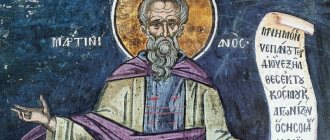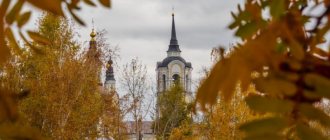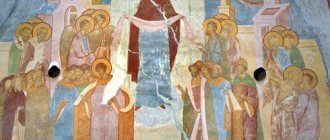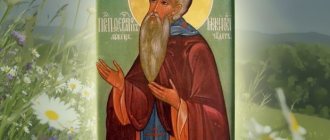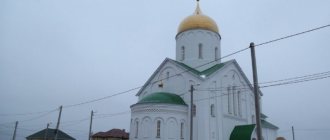Men's name days
Often, choosing a name according to the calendar is complicated by the dissonant combination of first and patronymic or the lack of options for male names for a particular day. In this case, it would not be a mistake to name a boy born on October 17 after the saint who is commemorated in the days immediately following the birth of the child.
On October 17, according to the Orthodox calendar, the days of the angel are celebrated for 11 men
.
Patron Saint: Jacob Bobyrev, hieromartyr, priest New Martyr, 2000
Meaning of the name: Jacob - from other Hebrew. next; old Jacob.
Derivatives: Yakovka, Yakupya, Yakukha, Yakusha, Yasha, Yashata, Yashunya, Yashuta, Yashogiya, Yanya, Yasya.
Name days: January 8, 13, 17, 26, February 10, 11, 17.
Patron Saint: Vasily Tsvetkov, Venerable Martyr, Archimandrite New Martyr, 2003
Meaning of the name: Derived from the ancient Greek word meaning: royal, royal. It appeared from the time of the Persian wars and initially had the meaning of “Persian king, prince, ruler.” The child loves to tinker with.
Patron saint: Vladimir Yaroslavich of Novgorod, prince
Name meaning: owner of the world
Patron saint: Vladimir Yaroslavich of Novgorod, prince
Name meaning: Famous ruler
Patron Saint: Demetrius Ascension, priest, hieromartyr New Martyr, 2001
Meaning of the name: Dmitry secret name - from Greek: related to Demeter, in ancient mythology Demeter is the goddess of fertility and agriculture; colloquial Mitriy; colloquially Mithraeus; old
Patron Saint: Mikhail Tverdovsky, Hieromartyr, Priest New Martyr, 2000
Name meaning: Smart, kind. Calculation and emotionality are two antipodes of character. Troubles are taken to heart. Good logical thinking helps you quickly navigate the environment. Mostly.
Patron Saint: Nikolai Vereshchagin, Hieromartyr, Priest New Martyr, 2000
Meaning of the name: NICHOLAY - winner of nations (Greek).
Name day: May 22 - The Venerable Martyr Nicholas Vuveni, suffered from the Avars in Thessaly. December 19 - Saint Nicholas the saint, miracle worker, archbishop.
Patron Saint: Pavel the Simple, Venerable
Meaning of the name: Pavel is calm, balanced, kind and gentle. In childhood it is simply a joy for the mother. Responsive, able to sympathize and empathize. These traits persist in Paul's character into adulthood. He.
Patron Saint: Peter of Capetolia, Damascus, martyr, presbyter
Name meaning: 1. Personality. Men of the heart.
4. Vibration. 114,000 vibrations/s.
6. Main features. Intuition - activity -.
Patron Saint: Stefan Šiljanović, Serbian, King
List of female church names for October
From time immemorial, parents named their children according to the Saints, according to the church charter. This gave the child a heavenly patron. The table below will help you make the right choice of church name for girls born in October.
| October | |
| October 1 | Ariadne, Euphrosyne, Irina, Sophia, Teresa |
| 2 October | Zosima |
| October 3 | Tatiana, Theopistia |
| The 4th of October | Agnia, Vassa |
| October 5 | And she |
| October 6 | Iraida, Xanthippe (Xanthippe), Polyxenia, Rebekah |
| October 7th | Thekla |
| October 8 | Euphrosyne, Laura, Theodulia, Tatta |
| October 9 | Hira |
| October 10 | Aquilina, Gayania, Dorothea, Epicharia, Zina, Fevronia |
| October 11 | Zosima, Kuksha, Maria, Juliania |
| October 12 | Agricola, Casdoia, Petronia |
| October 13 | Gayania (Gaiania), Maria, Hripsimia |
| October 14 | Vera, Gothia, Denegotia, Digna, Saturnina, Favstina |
| October 15 | Aurelia, Anna, Teresa, Justina (Justina, Ustinya) |
| October 16 | Feodosia, Yadviga |
| 17 October | Virinea (Veronica), Damara, Domnina, Jonah, Callisthenia, Prosdoka (Proscudia) |
| October 18 | Jonah, Mamelpha (Manetha), Charitina |
| October 19 | Erotiida, Laura |
| The 20th of October | Adeline, Alina, Pelageya |
| October 21 | Pelageya, Petronia, Taisiya, Ursula |
| 22 of October | Athanasia, Poplia |
| October 23 | Evlampia, Mina |
| October 24 | Quiz, Zinaida, Filonilla |
| the 25th of October | Anfiya, Domnika |
| October 26 | Agafonika, Zlata, Papila, Khrisiya |
| 27th October | Praskovya |
| 28 of October | Vevey |
| 29th of October | Viola, Eupraxia, Euphrosyne |
| October 30 | Hosea |
| October 31 | Kirmidola (m), Chrysa (Zlata) |
Men's name day October 17
Patron Saint: Jacob Bobyrev, hieromartyr, priest New Martyr, 2000
Meaning of the name: Jacob - from other Hebrew. next; old Jacob.
Derivatives: Yakovka, Yakupya, Yakukha, Yakusha, Yasha, Yashata, Yashunya, Yashuta, Yashogiya, Yanya, Yasya.
Name days: January 8, 13, 17, 26, February 10, 11, 17.
Patron Saint: Vasily Tsvetkov, Venerable Martyr, Archimandrite New Martyr, 2003
Meaning of the name: Derived from the ancient Greek word meaning: royal, royal. It appeared from the time of the Persian wars and initially had the meaning of “Persian king, prince, ruler.” The child loves to tinker with.
Patron saint: Vladimir Yaroslavich of Novgorod, prince
Name meaning: owner of the world
Patron saint: Vladimir Yaroslavich of Novgorod, prince
Name meaning: Famous ruler
Patron Saint: Demetrius Ascension, priest, hieromartyr New Martyr, 2001
Meaning of the name: Dmitry secret name - from Greek: related to Demeter, in ancient mythology Demeter is the goddess of fertility and agriculture; colloquial Mitriy; colloquially Mithraeus; old
Patron Saint: Mikhail Tverdovsky, Hieromartyr, Priest New Martyr, 2000
Name meaning: Smart, kind. Calculation and emotionality are two antipodes of character. Troubles are taken to heart. Good logical thinking helps you quickly navigate the environment. Mostly.
Patron Saint: Nikolai Vereshchagin, Hieromartyr, Priest New Martyr, 2000
Meaning of the name: NICHOLAY - winner of nations (Greek).
Name day: May 22 - The Venerable Martyr Nicholas Vuveni, suffered from the Avars in Thessaly. December 19 - Saint Nicholas the saint, miracle worker, archbishop.
Patron Saint: Pavel the Simple, Venerable
Meaning of the name: Pavel is calm, balanced, kind and gentle. In childhood it is simply a joy for the mother. Responsive, able to sympathize and empathize. These traits persist in Paul's character into adulthood. He.
Saints names for girls in October
The month begins with the veneration of the memory of the holy martyrs Ariadne of Phrygia, who lived in the 2nd century, Irene and Sophia of Egypt.
07.10 commemorates St. Theclas of Iconium. This is the first woman to suffer torment for the Christian faith. She was sentenced to death several times, but each time, by God's providence, she remained alive. For her feat, Thekla is equated with the apostles, and therefore is called equal to the apostles. Unfortunately, girls are hardly ever called by this name, meaning “glory of God,” these days.
On the 11th the name day of the Venerable Mary of Radonezh, mother of the famous Sergius of Radonezh, is celebrated.
14.10 - a major religious holiday - the Intercession of the Most Holy Theotokos (Pokrova). The event is celebrated in honor of the appearance of the Heavenly Queen in one of the temples where people prayed, calling on the help of the Almighty. The Mother of God took off her veil and spread it over the people. The people's aspirations were justified, and the enemies retreated from the city.
Erofeev day
Hieromartyr Hierotheos of Athens, bishop.
Dedicated to Saint Hierotheos, dedicated by the Apostle Paul to the rank of bishop. He suffered martyrdom in the 1st century.
Saint Hierotheos was one of the members or advisers of the Areopagus. He was converted to Christianity by the Holy Apostle Paul and was appointed bishop of the city of Athens by him. Present together with the apostles at the burial of our Most Holy Lady Theotokos, Saint Hierotheus sang divine hymns as he escorted the Most Pure Body of the Mother of God to the tomb, so that everyone who heard and saw it recognized him as a righteous and holy man. Having lived piously, as befits a saint, and having pleased God with his life and good management of his flock, Saint Hierotheus died as a martyr in the 1st century after the Nativity of Christ.
Discovery of the relics of Saints Guria, Archbishop of Kazan and Barsanuphius, Bishop of Tver
A holiday in honor of the discovery of the relics of two saints - Guria and Barsanuphius. This event occurred in Kazan in 1595 during the construction of a new stone church in the Spaso-Preobrazhensky Monastery.
The discovery of the relics of Saint Gury, Archbishop of Kazan (+ 1563), and Barsanuphius, Bishop of Tver (+ 1576), took place in Kazan in 1595. During the construction of a new stone church in honor of the Transfiguration of the Lord in the Transfiguration Monastery of the Savior, founded by St. Barsanuphius, coffins with the bodies of the saints were dug up near the altar wall of the former wooden church. The unusual appearance of the incorruptible coffins filled Saint Hermogenes (February 17) with reverent boldness to open the coffins in front of a large crowd of people. Saint Hermogen himself describes this event as follows:
“It’s a miracle to see, but we didn’t expect it. The holy cancer is full of the fragrant myrrh, like pure water, and the relics of Saint Guria are at the top of the world, like a lip worn. God grant incorruption to his honest and laborious body, as even now it is visible to everyone. I only touched the decay of my upper lip, but the rest of his lips were intact and unharmed. By touch, his funeral vestments and byakhu are very strong. Then we opened the shrine of St. Barsanuphius and saw: with many incorruptibles, venerate from God the relics of St. Barsanuphius. I touch the saint’s feet with corruption, but not only are the bones not destroyed, but they are very strong and there is no weakness in the composition of the property, just like Saint Guria. And the funeral vestments, like those of the Venerable Gurias, are stronger than the new ones.”
Many sick people were healed by being anointed with the holy myrrh that flowed from the relics of St. Gury.
The Iconographic Original for October 4 says:
“Guriy is like gray-haired, brada, like Basil of Caesarea, in a hat, in an omophorion, in his hands a Gospel, a saint’s robe. Barsanuphius, in the likeness of a priest, sat on a bridle, like Guriev, at the end of a bifurcated cap, wearing a holy robe, an omophorion and the Gospel.”
In accordance with the report of Archbishop of Cheboksary and Chuvashia Veniamin (Novitsky; + October 14, 1976), His Holiness Patriarch of Moscow and All Rus' Pimen blessed to create a cathedral commemoration for all Kazan saints on the first Sunday after October 4.
Events of October 17 in Ukraine and the world
- 1113 – Kiev-Mikhailovsky Golden-Domed Cathedral was built.
- 1888 – The crash of the royal train near Kharkov.
- 1604 - German astronomer Johannes Kepler began observing a supernova (SN 1604), later named after him.
- 1831 - Michael Faraday made the first successful test of an electric dynamo, discovering electromagnetic induction.
- 1855 - Englishman Henry Bessemer patented his process for preparing steel.
- 1902 - The first Cadillac car was released in Detroit.
- 1933 - Albert Einstein arrived in New York as a refugee from Nazi Germany.
- 1956 - The world's first automatic mobile communication system was launched in Sweden.
- 1990 - The world's largest database of films, television programs and computer games, IMDb, was launched.
- 2009 - two tourist planes collided in the skies over southwest France; four dead.
An-26 crash near Chuguev: who will be found guilty
Subscribe to the daily email newsletter from the creators of the number 1 newspaper in Ukraine. Every evening in your inbox the most important, exclusive and useful. Subscribe .
Hieromartyr Peter of Capetolia
The feast of St. Peter originates from the Capitol. He was a presbyter. He was tortured to death by Muslims for his faith in Christ.
Saint Peter lived at the turn of the 7th–8th centuries and was from the city of Capitolia. He admired everyone with his wisdom and intelligence. Peter married and had three sons. But since his love for God was stronger than his love for his family, he separated from his wife and became a monk. Then the bishop of Bostra, against the will of Peter, ordained him as a presbyter.
Having become seriously ill at the age of sixty, Peter lamented that the crown of martyrdom might pass him by. Then, having summoned eminent Muslims, instead of the promised testament, he fervently confessed the Christian faith to them and ended with sharp denunciations of Islam. Against all expectations, Peter recovered and, increasingly eager to join in the glory of the martyrs, began to preach zealously, condemning the errors of Muslims on the streets and in public places. The Muslims of the Capitol drew up a denunciation, which they sent to Omar, the son of Caliph Walid I.
When meeting with the official sent to interrogate him, Peter showed the same determination as before, and was therefore thrown into prison. At this time, the caliph fell ill and called his children to Damascus. Taking this opportunity, Omar explained to his father the case of a Christian priest. Walid ordered the accused to be brought in immediately. Fearing that they would never see their priest again, the Christians of the Capitol united and followed him part of the way.
As soon as Peter arrived at the Caliph's palace, Omar called him and asked him to choose between life and death. The saint answered passionately and vividly, making it clear that he wished to die, so that the angry Omar immediately sent him to his father. The caliph declared to the saint that he was free to consider Jesus Christ God, but calling the Prophet Muhammad the father of lies was impermissible. Peter responded in such a way that the caliph refused further trial and announced the verdict, choosing a sophisticated and cruel execution.
On January 10, 715, the holy martyr was brought back to the Capitol and exposed before all the people. In the front rows of the spectators were his son and daughter, who for this purpose were forced to leave the cells where they had lived since childhood. Following the orders of the caliph, the executioner tore out the martyr's tongue. The next day he cut off his foot and hand. On Sunday, with an even larger crowd of people, he cut off Saint Peter’s other foot and another hand, then blinded him, after which he crucified him near the monastery, in which he placed his daughters and next to which he died, pierced by three blows of a spear.
The soldiers guarded the saint's body for five days, after which they burned and threw the remains into the nearest river stream and even carefully washed any object that could touch the holy relics in order to prevent the believers from paying veneration to them.
Blessed Prince Vladimir Yaroslavich of Novgorod, wonderworker
Veneration of the eldest son of Grand Duke Yaroslav the Wise. The memory of the holy Prince of Novgorod Vladimir was established in 1439.
He was the eldest son of Grand Duke Yaroslav the Wise and his wife Indigerda, in monasticism Anna (+ 1056; commemorated February 10, old style). At the age of 14, his father made him governor of Novgorod. In governing the principality he was assisted by the governor Vyshata and the holy bishop Luka Zhidyata ((1060, commemorated February 10, old style). Having matured, the prince became a brave defender of the fatherland and a pious Christian. The prince diligently studied the law of the Lord, and in 1047 there were prophetic books with interpretation were rewritten.
Saint Vladimir built the St. Sophia Cathedral in Novgorod, consecrated on September 14, 1052 by Bishop Luke; On his order, a stone fortress was built in Novgorod. The holy prince died at the age of 32 on October 4, 1052, twenty days after the consecration of the St. Sophia Church, where his holy relics were placed. In 1439, Saint Euthymius, Archbishop of Novgorod ((1458; March 11, old style) established the memory of St. Prince Vladimir on October 4.

